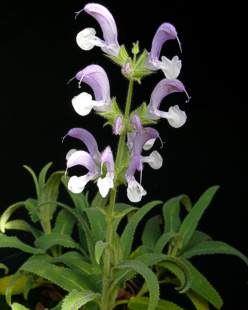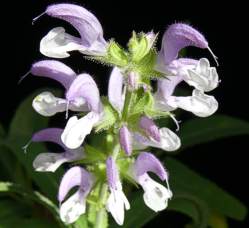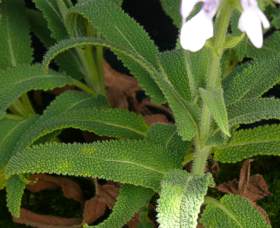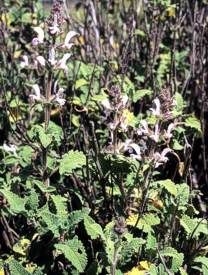Salvia disermas
Salvia disermas L.
Family: Lamiaceae
Common names: wild giant sage, Transvaal sage Eng.; grootsalie, teesalie Afr.; mogasane (Tswana)
Introduction
Occurring in a variety of colors and growth forms, the petite, pretty flowers of Salvia disermas will add charm to any garden in need of a hardy, flowering herbaceous perennial.

Description
Description
Relatively fast growing Salvia disermas is a herbaceous perennial shrub, 0.3-1.2m. It has upright growth, although some forms have a sprawling habit. Multiple stems grow from a slightly woody rootstock. As with all members of the sage family, the stems are square.
The entire plant is covered in soft hairs. Opposite, lobed and bluntly toothed leaves have a rough texture and are dull grayish green. When crushed the leaves produce a sweet aroma.
Flower stems are produced from terminal buds and occur on short spikes with flowers clustered at intervals.
The flower is typical of sage with a two-lipped corolla. The upper lip is hooded and houses the stigma and anthers, while the lower lip is cupped with the edges turned down, providing a platform for pollinators. The flowers are small but variable. White, pink, blue and bicolor forms have been described. Individual flowers are surrounded by a calyx which, in some forms, color with age. Flowering occurs in spring and summer.
Black or dark brown, shiny seeds are visible at the base of the calyx and fall out when ripe.


Conservation Status
Status
Salvia disermas is not threatened.
Distribution and habitat
Distribution description
The teesalie is quite widespread and has been recorded throughout South Africa and in Namibia. It occurs at altitudes of 360-1555 m in well drained, rocky or stony soil.
Derivation of name and historical aspects
History
Pliny the Elder, a Roman scientist and historian, was the first to use the name Salvia.
The virtues of sages have been found, in old herbal woodcuts and engravings of medieval and renaissance Europe, giving medicinal recipes or describing charms or spells.
Salvias have been popular since the 1970's for ornamental gardening.
Salvia is presumably derived from the Latin, salvus, meaning uninjured, whole, safe, well or sound and salvare meaning to save or heal (verb salvere, to be in good health), referring to the medicinal value of the plants.
The latin root, dis, meaning two or different and mas meaning robustness of plant, hint at the description for disermas.
Synonymy for Salvia disermas include Salvia fleckii, Salvia rugosa, Salvia rugosa and Salvia rugosa var. angustifolia.
Salvia is the largest genus in the Lamiaceae family. The genus Salvia consists of approximately 900 species made up of annuals, perennials and shrubs. They are widely distributed around the world in warm temperate and tropical regions. Twenty-seven species are found naturally in South Africa. Noteworthy South African sages are Salvia africana-lutea, S. africana-caerulea, S. chamelaeagnea, S. muirii and S. thermarum. Sages are commonly grown as ornamentals.
Ecology
Ecology
Bees and insects are attracted to salvia flowers. The filaments of the stamens are hinged, which gives them mobility, allowing them to attach pollen to visiting pollinators.
The flowers are adapted to the bees to carry out pollination. The lower lip of the flower is a platform on which the bee lands. As the bee probes for nectar, it presses against the hinged filament of the stamen, which causes the stamen to move down and the anther to touch the bee, rubbing pollen onto the bee's back. When the bee enters another flower of the same species, the pollen will rub against the stigma of the other flower and, if receptive, cross pollination will be successful.
Uses
Use
Most sages contain essential oils and have long been used in cooking and medicine all over the world.
Salvia disermas' aromatic leaves are used as a substitute for tea and used in cooking, although very sparingly. A lotion can be made for skin rashes, stings, bites, pimples, infected scrapes, scratches and sores. A little of this brew or a tea is taken as a tonic to re-energize the body after a long illness and to bring down fevers. A teaspoon at a time of this tea is a good heartburn remedy.
Lotion is made by steeping one cup of fresh leaves and stems in 2 liters of hot water for 15 minutes. Tea is prepared by steeping one teaspoon of fresh leaves and flowers in one cup of boiling water for 5 minutes.
Growing Salvia disermas
Grow
The Transvaal sage is used as a perennial for summer colour displays. It also makes an attractive rockery specimen, with excellent drainage being essential.
S. disermas grows well in pots with well drained composted soils.
New plants are planted out at the end of spring. Salvia disermas is easily combined with most yellow, white or pink flowering perennials such Lasiospermum bipinnatum, Diascia integerrima and Osteospermum jucundum. They also give good contrast with Fynbos such as Restionaceae, Proteaceae and Erica.
The fast growing plants get untidy after 2-3 years and need to be pruned back hard or lifted and replanted.

Salvia disermas requires full sun with good drainage. It will survive with little water but responds well to regular watering, especially in summer. No extra feeding is necessary for strong, healthy growth although an occasional foliar feed would do no harm.
New plants are easy to propagate from seed, cuttings or division of the creeping rootstock.
Sow seeds late spring and early summer into general potting soil mix. Seedlings germinate quickly and seedlings can be transplanted into well drained potting soil once first pair of true leaves appear.
Take semi-hardwood tip cuttings in spring and summer. Cuttings must be without terminal flowering bud. Place in rooting medium, 50% fine milled bark and 50% polystyrene (perlite, vermiculite and peat are alternatives). Place under mist or enclose in plastic bag to retain humidity. Keep warm but out of direct sunlight.
The hairy and aromatic leaves the plants do not have any major pest, although mealy bug can settle down near the base of the plant stems and leaves.
References
- Clebsch, B. 1997. A book of Salvias, Sages for every Garden. Timber Press, Oregon.
- Fox, E.W. & Norwood Young, M.E. 1982. Food from the Veld, Edible wild plants of southern. Africa Delta Books (Pty) Ltd, Johannesburg.
- Hyam, R. & Pankhurst, R. 1995. Plants and their names, a concise dictionary. Oxford University Press, New York.
- Leistner, O.A. (ed.). 2000. Seeds plants of southern Africa : families and genera. Strelitzia 10. National Botanical Institute, Pretoria.
- Roberts, M. 1990. Indigenous Healing Plants. Southern Book Publishers, Halfway House
- Smith, C.A. 1966. Common names of South African plants. Memoirs of the Botanical Survey of South Africa No. 35.
- Stearn, W.T. 2002. Stearn's dictionary of Plant Names for gardeners. Timber Press, Oregon.
Credits
Monique McQuillan
Kirstenbosch National Botanical Garden
January 2009
Plant Attributes:
Plant Type: Perennial, Shrub
SA Distribution: Eastern Cape, Free State, Gauteng, North West, Northern Cape
Soil type: Sandy
Flowering season: Spring, Early Summer, Late Summer
PH: Acid, Neutral
Flower colour: White, Pink, Mauve/Lilac
Aspect: Full Sun
Gardening skill: Average
Special Features:
Horticultural zones











Rate this article
Article well written and informative
Rate this plant
Is this an interesting plant?
Login to add your Comment
Back to topNot registered yet? Click here to register.